Structure of the hydroxyl (-OH) functional group

The suffix –ol is used in organic chemistry principally to form names of organic compounds containing the hydroxyl (–OH) group, mainly alcohols (also phenol). The suffix was extracted from the word alcohol.
The suffix also appears in some trivial names with reference to oils (from Latin oleum, oil). Examples of this sense of the suffix include phenol, eugenol, urushiol, and menthol.
Nomenclature
The IUPAC name of alcohols can be obtained through the following rules:
- Identify the longest carbon chain, and number each carbon. Name the base alkane according to the organic nomenclature rules.
- Identify the hydroxyl group, and which carbon it is on. To be an alcohol, the -OH must be bonded to a carbon.
- Use the suffix -ol to denote which carbon the alcohol group is on. For example, a three-carbon chain with the -OH on the second carbon would be written propan-2-ol under these rules. Note that in some instances common names are preferred.
- If the -OH is on the end of the chain, or the carbon chain is only 1 or 2, no number is needed.
- Use standard Greek prefixes to name molecules with two or more -OH groups (di- for 2, and so on).
Examples
- Methanol
- Ethanol
- Isopropanol
- Phenol
- Erythritol
- Glycol
- t-Butyl alcohol
References
- ^ International Union of Pure and Applied Chemistry. Commission on the Nomenclature of Organic Chemistry. (1993). A guide to IUPAC nomenclature of organic compounds : recommendations 1993. Panico, Robert, 1925-, Powell, Warren H., 1934-, Richer, Jean-Claude. Oxford: Blackwell Scientific Publications. ISBN 0-632-03702-4. OCLC 27431284.
- International Union of Pure and Applied Chemistry, Commission on Nomenclature of Organic Chemistry (1993). Panico R; Powell WH; Richer JC (eds.). A guide to IUPAC nomenclature of organic compounds: recommendations 1993. Oxford: Blackwell Scientific Publications. ISBN 0-632-03702-4.